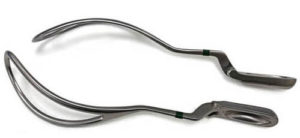What happens during a forceps delivery?
During a forceps delivery, the doctor uses special tools that resemble salad tongs to help pull the baby out when vaginal labor becomes prolonged or complicated. Before the doctor can use forceps, the mother’s cervix must be fully dilated and her membranes must be broken.
 The obstetrician inserts the forceps one at a time and locks them in position around the baby’s head. Then, as the mother pushes during contractions, the doctor guides the baby through the birth canal.
The obstetrician inserts the forceps one at a time and locks them in position around the baby’s head. Then, as the mother pushes during contractions, the doctor guides the baby through the birth canal.
If forceps are improperly used, however, they can cause the following complications:
- Brain damage (which can lead to cerebral palsy)
- Erb’s palsy
- Rectal or vaginal tears in the mother
- Seizures
- Skull fractures
Sometimes, the mother will also undergo an episiotomy. An episiotomy is an incision made in the perineum (the tissue between the vagina and anus) that creates space for the forceps to be inserted and the baby to be delivered.
If you had a forceps delivery and experienced complications from the procedure, share your story with one of our trusted registered nurses today to learn about your options.
When is a forceps delivery necessary?


There are many different ways to deliver a baby. In cases of complicated or prolonged labor, doctors may use tools like forceps or vacuum extraction to perform an operative vaginal delivery. These tools are generally used in the second stage of labor.
There are times when using forceps is appropriate and times when it’s absolutely necessary — and then there are also times when it shouldn’t be done.
- A forceps delivery may be the safest option when:
- The baby is delivered with face presentation (when the back of the baby’s skull is against the baby’s own upper back)
- The baby is premature
- The baby is stuck in the birth canal and showing signs of fetal distress
- More than one baby is being born
- The mother has high blood pressure, heart disease, or other health issues that make pushing risky
- The mother is too tired to keep pushing during contractions
- A forceps delivery should not be done when the baby:
- Can’t fit through the mother’s pelvis
- Has a bleeding disorder or weak bones
- Is in an unknown position
- Is leading with their arms or shoulders during birth
Health care professionals are required to understand when this type of assisted delivery reduces the risk of injury and when it might have the opposite effect. If you or your baby are injured as a result of the doctor using forceps during delivery, contact us today to find out if you can file a lawsuit.
What are the risks of a forceps delivery?
The risks of a forceps delivery include severe injuries to the baby and/or mother. Babies can be left with long-term birth injuries and permanent impairments like cerebral palsy depending on the damage done by forceps.
Health care professionals should be aware of the risks associated with the use of forceps and take the necessary precautions to prevent accidents.
Although it’s normal for a baby to have temporary marks on their face and skull after a forceps delivery, there are other possible medical conditions that are not normal — and sometimes cause lasting damage. Learn about the health problems often linked to forceps below.
Birth injuries
When a forceps delivery is performed poorly or when another option would’ve been safer, birth injuries may occur. Although some birth injuries are minor and can heal on their own, others can severely impact the child’s quality of life for years to come.
Possible risks to a baby from forceps delivery complications include:
- Bone and skull fractures
- Brain damage
- Bruises and lacerations (cuts) to the head and face
- Intracranial hematoma (bleeding inside the skull)
- Shoulder dystocia (shoulders become stuck after the head of the baby is delivered)
- Seizures
- Temporary facial palsy (nerve damage in the baby’s face that leads to muscle weakness and drooping)
If you believe your child’s birth injury could have been prevented and was caused by medical negligence during a forceps delivery, you may be able to seek legal help.
Cerebral palsy
Cerebral palsy refers to a group of movement disorders that affects the nervous system. It is a lifelong disability that prevents the brain from controlling the body’s muscles. While treatments can improve mobility and reduce symptoms, there is no cure.
Cerebral palsy often stems from brain damage at birth, and damage to different areas of the brain leads to different symptoms of cerebral palsy, such as abnormal posture, inability to stand up, and difficulty speaking.
Forceps use may increase the risk of brain damage — and cerebral palsy — in a baby.
Symptoms of cerebral palsy may include:
- Abnormal muscle tone
- Delays in mobility (crawling, rolling over, walking)
- Hearing and/or vision problems
- Inability to lift the head or stand
- Trouble holding onto items or clapping hands
- Uncontrollable muscle movement
Cerebral palsy may require extensive treatment and accommodations for the rest of the child’s life.
Erb’s palsy
Whereas cerebral palsy comes from damage to the brain, Erb’s palsy occurs due to nerve damage in the shoulder, arm, or hand (the area known as the brachial plexus).
Erb’s palsy is the most common type of birth-related brachial plexus injury, followed by Klumpke’s palsy.
Erb’s palsy may happen in cases of shoulder dystocia, in which one or both of the baby’s shoulders gets stuck in the mother’s pelvis during vaginal birth.
Sometimes the doctor pulls on the baby with forceps to dislodge the shoulder, which may stretch or tear the nerves in the baby’s brachial plexus. This type of brachial plexus injury may lead to Erb’s palsy.
Symptoms of Erb’s palsy include:
- Limited motion in the arm
- Numbness in the arm or hand
- Paralysis of the shoulder, arm, or elbow
- Waiter’s tip position (the arm hangs by the side and the wrist turns inward)
Even though most (about 80%) of those with Erb’s palsy will fully recover, medical expenses can add up quickly.
Fortunately, the experienced attorneys we work with can help victims pursue compensation to cover those costs. Get a free case review and learn how to get started.
Can forceps delivery injuries be treated?
Yes, all forceps delivery injuries can be treated.


Mothers who experience minor injuries during a forceps delivery generally need minimal treatment. Those who have an episiotomy or suffer a vaginal tear may need dissolvable stitches, and some may also need a catheter to address urinary incontinence (loss of bladder control) for up to a day after delivery.
Forceps delivery complications can lead to a wide range of injuries, so the hospital staff should always check on both the mother and baby after an assisted delivery.
Can you sue for forceps delivery complications?
Possibly, yes. When a health care professional makes a mistake and a patient is injured as a result, that person (or their family) may be able to sue for medical malpractice.
A forceps delivery is not a risk-free procedure, so doctors must understand when it should and shouldn’t be done. If a health care professional makes the wrong decision and injures the mother or baby as a result, they may be held liable with a birth injury lawsuit.
In addition to the obstetricians, nurses, and other staff that can be held responsible for their behavior in the delivery room, the hospitals themselves may be liable for forceps-related birth injuries as well.
It’s the hospital's responsibility to ensure it hires and maintains a competent and properly trained staff to reduce the chances of forceps delivery complications.
If you or your child were harmed by forceps delivery complications, you may be entitled to compensation. Contact us today to learn about the steps you can take.
Filing a medical negligence claim for forceps delivery injuries
The health issues that may stem from forceps delivery complications can put a financial burden on families and loved ones.
A medical negligence lawsuit can allow you to seek compensation for:
- Doctor visits
- Medical equipment
- Medication
- Mobility assistance equipment
- Physical therapy
- Surgery
- And more
An experienced birth injury lawyer can help you file a medical negligence claim if you have a case. From there, your team will work to get you the maximum amount of compensation as quickly as possible. Get started with a free case review today.




